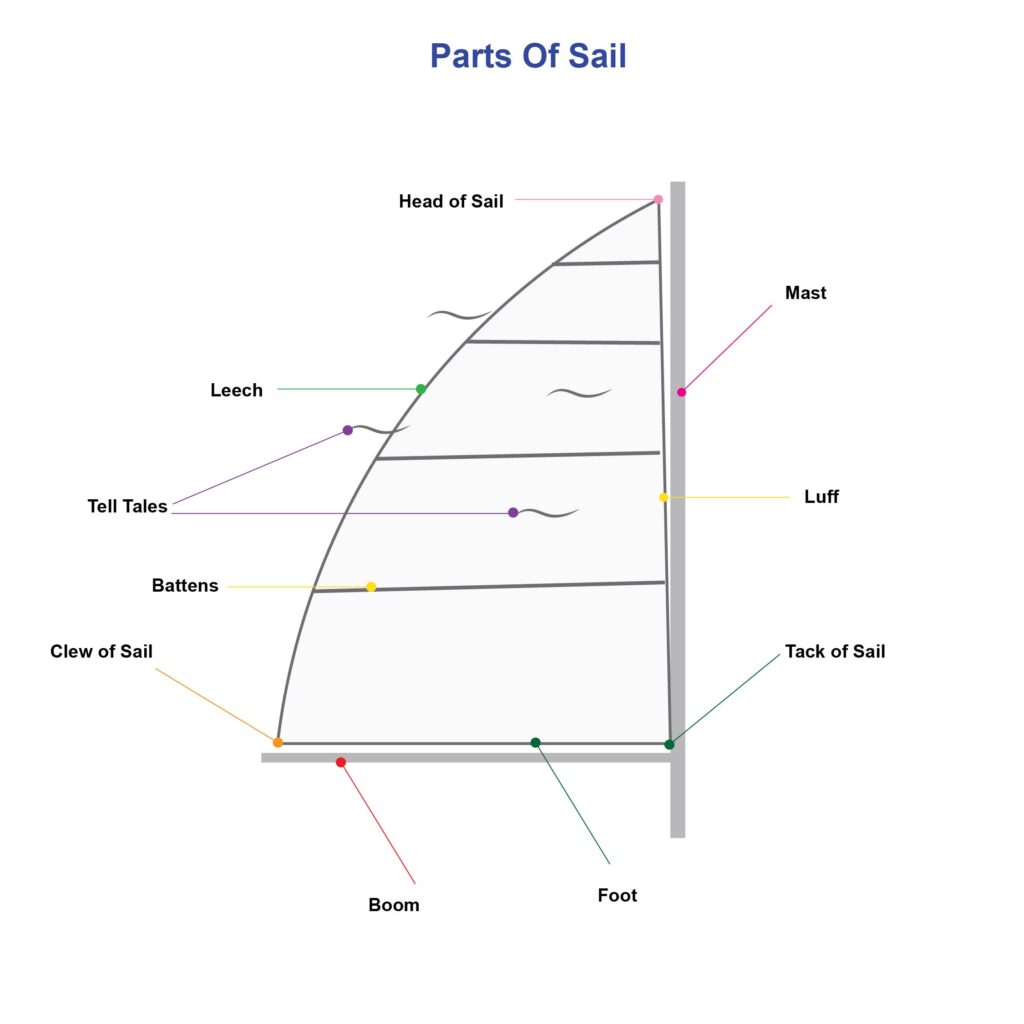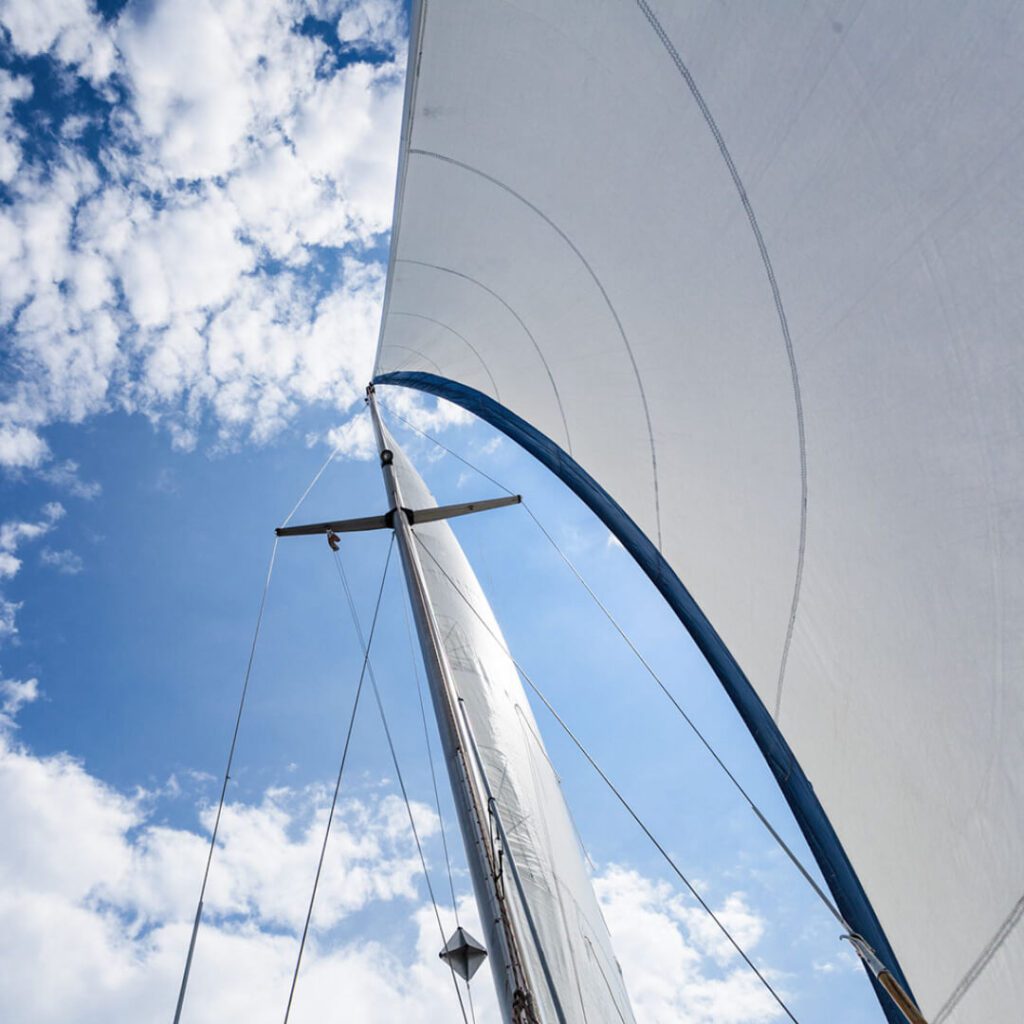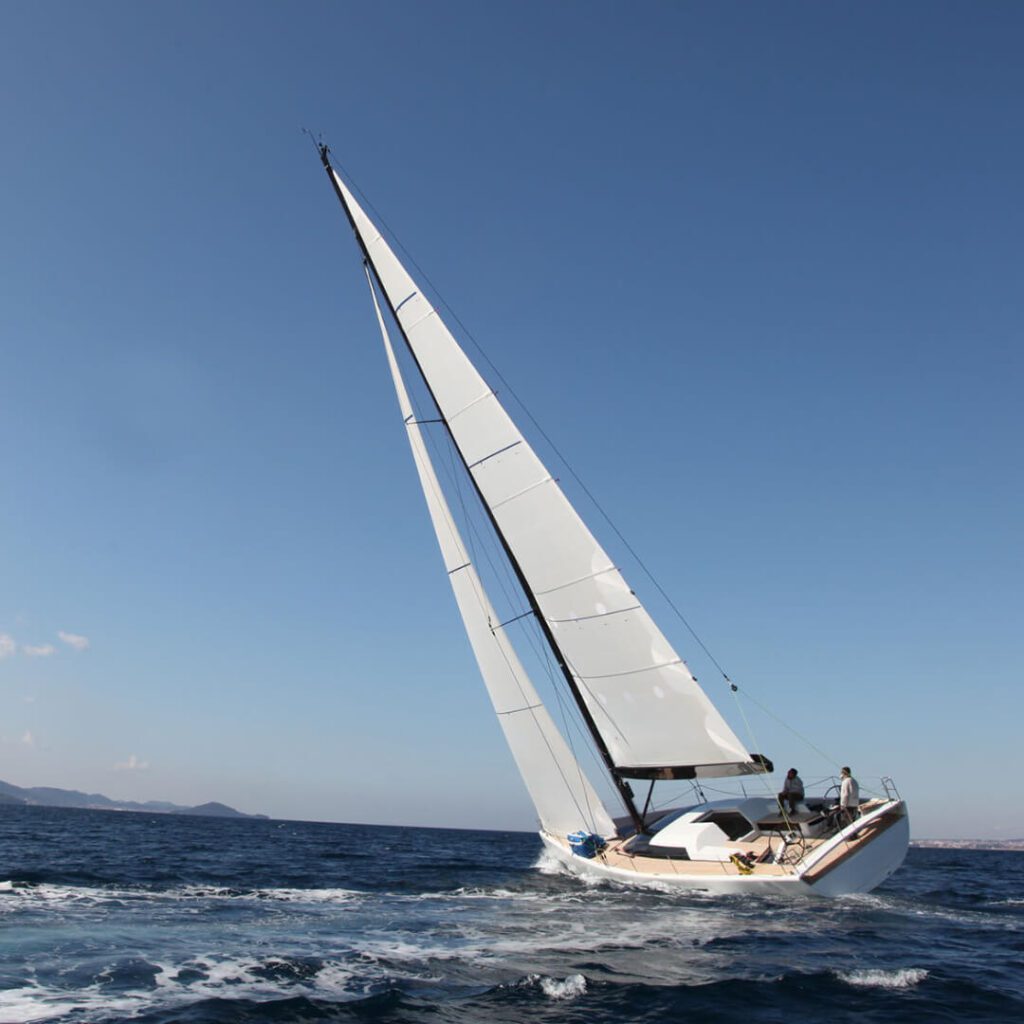I recently started sailing, and one of the things they teach you at sailing school is about the different parts of a sail. Sailing is an enjoyable and thrilling activity that requires knowledge of many parts of a sail.
A sail on a sailboat comprises several parts, including the three corners, the luff, leech, foot, and head. Understanding these parts is crucial for any sailor, whether a beginner or an experienced sailor. However, understanding these parts can help improve your sailing knowledge and experience. Read on as we explore the three corners of the sail and other important terms.
Table of Contents
- The Three Corners Of A Sail Explained
- The Luff, Leech, And Foot Connect The Three Corners Of A Sail
- Other Components Of A Sail To Understand
- Related Questions
The Three Corners Of A Sail Explained

A sail is like a giant triangle sheet, so each part has a corner. Each of these three corners has a name associated with them.
The three corners of a sail are the head, tack, and clew. Here are the different corners of the sail:
The Head Of The Sail Is The Top Corner
The head is the top corner of the sail, located at the top of the mast. If you look straight up the mast, this is the corner that you will see is being raised and lowered as you raise the sails.
I sail Ensign sailboats on Lake Michigan, and each time we go out to sail, we need to raise the mainsail. The very top of our main sail is considered the head of the sail.
The Tack Is The Bottom Forward Corner
At the opposite end of the sail is the tack, which is at the bottom forward corner. The tack is the bottom forward corner of the sail, located at the base of the mast.
You will know this is the tack of the sail as the tack is also attached to the mast but is at the bottom of the sail.
The Clew Is At The Bottom At the Corner
The clew part of the sail is at the bottom corner. It is the sailing part closest to the stern or the aft.
The clew is the bottom aft corner of the sail, located at the opposite end of the boom from the tack.
The Luff, Leech, And Foot Connect The Three Corners Of A Sail

There are also parts of the sail that connect the three corners that a sailor should understand. These terms are known as the luff, leech, and foot.
The Luff – Leading Edge Faces Into Wind
The “luff” of a sail refers to the leading edge of a sail that faces into the wind. It is the part of the sail attached to the mast and runs vertically along it.
The luff of a sail is typically designed to be as smooth and streamlined as possible to help the sail slice through the wind and generate lift.
The luff of a sail is essential because it helps to control the shape of the sail and how it interacts with the wind. When the wind hits the sail luff, it creates an area of high pressure on the front and low pressure on the back of the sail.
This pressure difference generates lift, which is what propels the boat forward. And learning how to control the luff and sail can make a difference between the boat going fast or slow when you are sailing.
The shape of the luff of a sail can be adjusted using various control lines, such as the halyard and the downhaul. By tightening or loosening these lines, sailors can adjust the tension on the sail’s luff and change its shape.
This can optimize the sail’s performance for different wind conditions, such as light winds or strong gusts.
In addition to controlling the sail’s shape, the luff is also essential for safety. A properly tensioned luff ensures the sail remains securely attached to the mast, even in strong winds. A good captain should check that the luff is not broken or damaged, especially when sailing in heavy winds.
The luff is essential for preventing the sail from tearing or separating from the boat, which could result in a dangerous situation for the crew. The luff of a sail plays a crucial role in sailboat performance and safety.
By understanding how to control and adjust the luff of a sail properly, sailors can optimize their performance and stay safe while out on the water.

The Leech – Attaches To The Back Of The Sailboat
The “leech” of a sail is the trailing edge that extends from the aft or stern (back) end of the sail to the clew. The leech plays a vital role in controlling the power and performance of the sail.
When wind hits the sail, it creates an area of high pressure on the front and an area of low pressure on the back of the sail. As the wind flows over the sail, it creates turbulence along the edges of the sail, including the sponge.
The turbulence can cause the sail to lose efficiency and generate drag, which slows the boat down.
To minimize this drag, sail designers typically design the sail’s leech to be as smooth and streamlined as possible. This is achieved by shaping the sponge with a gentle curve that tapers to a point at the end.
This way, designing the sponge allows the wind to flow smoothly over the sail, reducing turbulence and increasing efficiency.
The leech of a sail can also be adjusted using various control lines, such as the sheet and the boom. By tightening or loosening these lines, sailors can adjust the tension on the sail’s leech and change its shape.
A good sailor understands this and can change the sail according to the wing. They understand a sail’s performance will change for different wind conditions, such as light winds or strong gusts.
In addition to controlling the sail’s shape, the sponge is essential for safety. A correctly tensioned sponge ensures the sail remains securely attached to the boat, even in strong winds. This helps prevent the sail from flapping or fluttering, which could damage the sail, the boat, or the people on the boat.
Overall, the leech of a sail plays a crucial role in sailboat performance and safety. By understanding how to control and adjust the leech of a sail properly, sailors can optimize their performance and stay safe while on the water.
The Foot – The Bottom Edge Of The Sail Attached To The Boom
The “foot” of a sail is the bottom edge of the sail that runs horizontally along the boom. Like the luff and leech, the foot of a sail is an essential component of sail design that affects the sail’s performance.
The foot of the sail helps to control the sail’s shape and how it interacts with the wind. When the wind hits the sail, it creates an area of high pressure on the front and an area of low pressure on the back of the sail.
By learning to adjust the tension on the foot of the sail properly, sailors can change the sail’s shape and how it interacts with the wind.
A critical aspect of the foot of the sail is its “draft,” which refers to the curvature of the sail along its horizontal axis. The sail’s draft determines how much power it generates and how efficiently it slices through the wind.
For example, a sail with a deep draft will generate more power in light winds, while a shallow draft will be more efficient in strong winds. This shows why it is essential to sail a boat so that sailors understand not just the wind but also the best shape of the sail to use for each type of wind.
The tension on the foot of the sail can be adjusted using the sail’s control lines, such as the mainsheet and the outhaul. By tightening or loosening these lines, sailors can adjust the tension on the foot of the sail and change its shape to optimize its performance for different wind conditions.
In addition to controlling the sail’s shape, the foot is essential for safety. A correctly tensioned foot ensures the sail remains securely attached to the boom, even in strong winds. This helps to prevent the sail from flapping or flogging, which could cause damage to the sail, boat, or any of the crew on the boat.
Overall, the foot of a sail is a critical component of sail design that plays a vital role in sailboat performance and safety. By understanding how to control and adjust the foot of a sail properly, sailors can optimize their performance and stay safe out on the water.
These three parts of the sail, luff, leech, and foot, help to create the proper shape and form of the sail. Understanding these parts can help you catch the wind and propel the sailboat forward.

Other Components Of A Sail To Understand
In addition to these parts, a sail has other essential components, such as the reefing points, battens, and telltales.
Reefing points are lines or grommets on the sail that reduce the sail in size in high winds. Battens are stiff rods inserted into pockets on the sail to help maintain its shape and prevent it from fluttering in the wind.
Telltales are thin ribbons or threads attached to the sail that help indicate wind direction and trim.
When I am out sailing the boat, most sailors, myself included, will spend much of the time looking at the telltales to see the wind direction. This is very important if you are sailing in a place where the wind can change, as when we sail on Lake Michigan.
The telltales are important as they will help you understand if the wind suddenly changes direction, so you must adjust your point of sail.
Understanding the parts and components of a sail is essential for any sailor because it allows them to control the sailboat’s speed, direction, and stability. Knowing how to trim the sail by adjusting the tension on the lines and the angle of the sail to the wind is crucial for efficient sailing.
The position of the three corners of the sail and the shape of the sail itself will determine how much wind it catches and how fast the sailboat will move. Sailors also need to know how to reef the sail to reduce its size in high winds or to release it fully in light winds.
Understanding the parts of a sail, including the three corners, luff, leech, foot, and other components, is essential for any sailor. It allows them to control their sailboat’s speed, direction, and stability and to make the most of the wind.
As a sailor gains experience, their goal should be to become more familiar with the different parts of their sail and to understand when and how the sail should be adjusted to the wind or lack of wind.
Adjusting their sail trim instinctively will help make sailing enjoyable, relaxing, and rewarding.
At A Bus On A Dusty Road, we discuss culture, travel, life, sailing, and ex-pat living. We are all about “Living Life As A Global Citizen.” We explore social, cultural, and economic issues and travel.
We would love to have you be part of our community. Sign up for our newsletter to keep up-to-date by clicking here. If you have any questions, please contact me, Anita, by clicking here.
Listen to our Podcast called Dusty Roads. You can find it on all major podcast platforms. Try out listening to one of our podcasts by clicking here.
Subscribe to our A Bus On A Dusty Road YouTube Channel with great videos and information by clicking here.
Related Questions
What Is Jibing In Sailing? Steps To A Proper Controlled Jibe
A jibe in sailing is when the boat moves with the stern through the wind. In a jibe, the stern will move through the wind. Like any sailing maneuver, when you have a crew, the helmsman or the captain steering the boat needs to adequately communicate with the crew about what is happening so that they know; this is especially true when jibing.
By clicking here, you can discover What Is Jibing In Sailing? Steps To A Proper Controlled Jibe.
What Is Tacking In Sailing? Steps To A Proper Tack
Tacking is when you move the boat’s bow into the wind to turn the boat’s direction. It is a very common maneuver that all sailors must learn to master. But with any sailing maneuver, their proper steps, you must learn to do a proper and safe tack.
By clicking here, you can discover What Is Tacking In Sailing? Steps To A Proper Tack
What Is The Sailing Term For “No Wind”?
The term calm or calm is used to describe sailing with no wind, or there’s no wind for you to be able to sell your sailboat. In ancient times, the sailors also used the word tied over to indicate that there was no wind, so they were tied over or stuck without being able to sail.
By clicking here, you can discover What Is The Sailing Term For “No Wind”?


